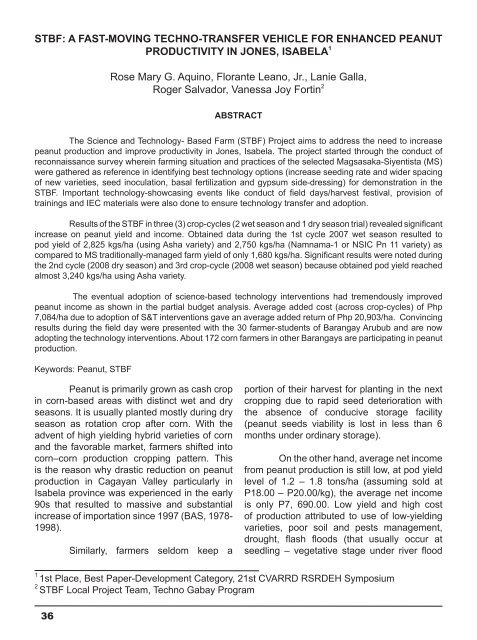download the full article here - EISRJC
download the full article here - EISRJC
download the full article here - EISRJC
You also want an ePaper? Increase the reach of your titles
YUMPU automatically turns print PDFs into web optimized ePapers that Google loves.
STBF: A FAST-MOVING TECHNO-TRANSFER VEHICLE FOR ENHANCED PEANUT<br />
PRODUCTIVITY IN JONES, ISABELA 1<br />
Rose Mary G. Aquino, Florante Leano, Jr., Lanie Galla,<br />
Roger Salvador, Vanessa Joy Fortin 2<br />
ABSTRACT<br />
The Science and Technology- Based Farm (STBF) Project aims to address <strong>the</strong> need to increase<br />
peanut production and improve productivity in Jones, Isabela. The project started through <strong>the</strong> conduct of<br />
reconnaissance survey w<strong>here</strong>in farming situation and practices of <strong>the</strong> selected Magsasaka-Siyentista (MS)<br />
were ga<strong>the</strong>red as reference in identifying best technology options (increase seeding rate and wider spacing<br />
of new varieties, seed inoculation, basal fertilization and gypsum side-dressing) for demonstration in <strong>the</strong><br />
STBF. Important technology-showcasing events like conduct of field days/harvest festival, provision of<br />
trainings and IEC materials were also done to ensure technology transfer and adoption.<br />
Results of <strong>the</strong> STBF in three (3) crop-cycles (2 wet season and 1 dry season trial) revealed significant<br />
increase on peanut yield and income. Obtained data during <strong>the</strong> 1st cycle 2007 wet season resulted to<br />
pod yield of 2,825 kgs/ha (using Asha variety) and 2,750 kgs/ha (Namnama-1 or NSIC Pn 11 variety) as<br />
compared to MS traditionally-managed farm yield of only 1,680 kgs/ha. Significant results were noted during<br />
<strong>the</strong> 2nd cycle (2008 dry season) and 3rd crop-cycle (2008 wet season) because obtained pod yield reached<br />
almost 3,240 kgs/ha using Asha variety.<br />
The eventual adoption of science-based technology interventions had tremendously improved<br />
peanut income as shown in <strong>the</strong> partial budget analysis. Average added cost (across crop-cycles) of Php<br />
7,084/ha due to adoption of S&T interventions gave an average added return of Php 20,903/ha. Convincing<br />
results during <strong>the</strong> field day were presented with <strong>the</strong> 30 farmer-students of Barangay Arubub and are now<br />
adopting <strong>the</strong> technology interventions. About 172 corn farmers in o<strong>the</strong>r Barangays are participating in peanut<br />
production.<br />
Keywords: Peanut, STBF<br />
Peanut is primarily grown as cash crop<br />
in corn-based areas with distinct wet and dry<br />
seasons. It is usually planted mostly during dry<br />
season as rotation crop after corn. With <strong>the</strong><br />
advent of high yielding hybrid varieties of corn<br />
and <strong>the</strong> favorable market, farmers shifted into<br />
corn–corn production cropping pattern. This<br />
is <strong>the</strong> reason why drastic reduction on peanut<br />
production in Cagayan Valley particularly in<br />
Isabela province was experienced in <strong>the</strong> early<br />
90s that resulted to massive and substantial<br />
increase of importation since 1997 (BAS, 1978-<br />
1998).<br />
Similarly, farmers seldom keep a<br />
portion of <strong>the</strong>ir harvest for planting in <strong>the</strong> next<br />
cropping due to rapid seed deterioration with<br />
<strong>the</strong> absence of conducive storage facility<br />
(peanut seeds viability is lost in less than 6<br />
months under ordinary storage).<br />
On <strong>the</strong> o<strong>the</strong>r hand, average net income<br />
from peanut production is still low, at pod yield<br />
level of 1.2 – 1.8 tons/ha (assuming sold at<br />
P18.00 – P20.00/kg), <strong>the</strong> average net income<br />
is only P7, 690.00. Low yield and high cost<br />
of production attributed to use of low-yielding<br />
varieties, poor soil and pests management,<br />
drought, flash floods (that usually occur at<br />
seedling – vegetative stage under river flood<br />
1<br />
1st Place, Best Paper-Development Category, 21st CVARRD RSRDEH Symposium<br />
2<br />
STBF Local Project Team, Techno Gabay Program<br />
36

















